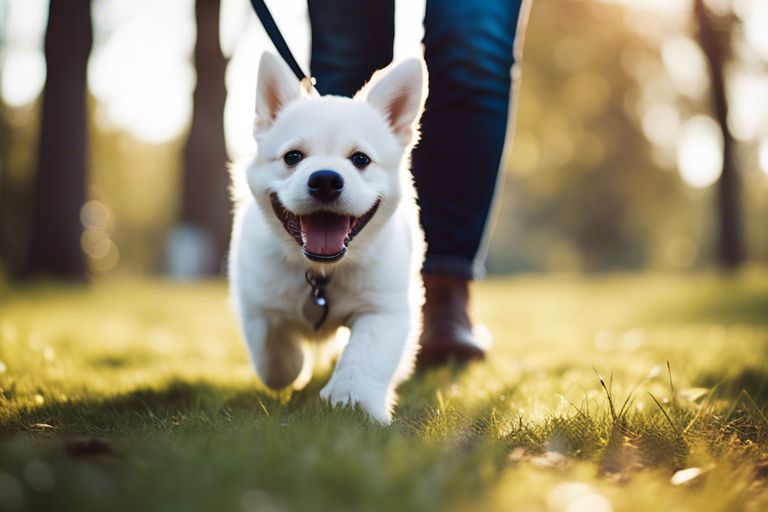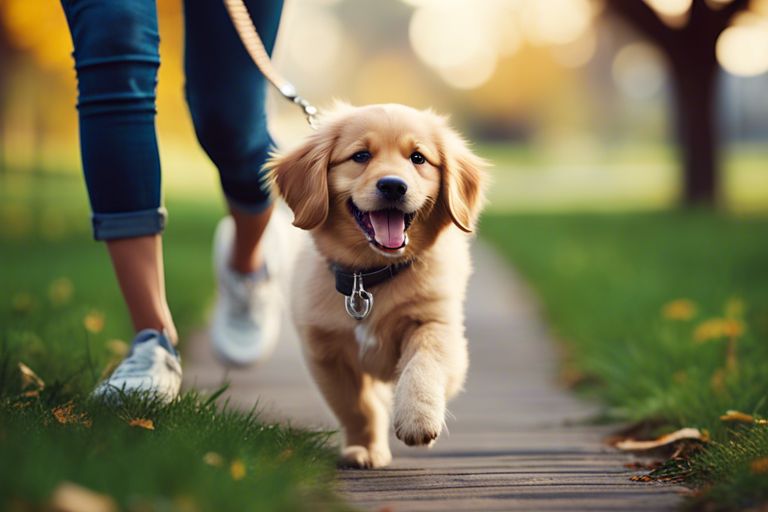You’ve just brought home your new furry friend and now it’s time to tackle leash training. Teaching your puppy to walk nicely on a leash is an important skill that will make future walks enjoyable for both of you. In this comprehensive guide, we will provide you with crucial tips and techniques to help you successfully leash train your puppy, building a strong foundation for a lifetime of happy walks together.
Key Takeaways:
- Start Early: Begin leash training your puppy as soon as possible to establish good habits early on.
- Use Positive Reinforcement: Reward your puppy with treats and praise when they walk nicely on the leash to encourage good behavior.
- Be Patient: Leash training takes time and consistency, so remain patient and consistent with your puppy to help them learn.
Understanding Your Puppy’s Needs
Before you start leash training your puppy, it is crucial to understand your furry friend’s needs. By recognizing these needs, you can tailor your training methods to suit your puppy’s individual requirements, making the process smoother and more successful.
Factors Affecting Leash Training Success
- Age and development stage of the puppy.
- Past experiences with leashes and collars.
- Personality and temperament of the puppy.
Recognizing and accommodating these factors can help you adjust your training approach and set realistic expectations for your puppy’s progress.
Identifying Your Puppy’s Breed-Specific Traits
While all puppies have unique personalities, recognizing breed-specific traits can play a significant role in leash training success. Different breeds have been bred for various purposes, such as hunting, herding, or companionship, which can affect their behavior and response to training.
Affecting how your puppy learns and interacts with the environment, breed-specific traits can influence the pace and methods used in leash training. Understanding these traits can help you anticipate challenges and tailor your training to ensure success.
Preparing for Leash Training
Some of the most crucial aspects of successful leash training your puppy involve setting the stage for a positive and effective training experience. Before venturing into the actual training process, it’s important to take the time to prepare properly.
Choosing the Right Equipment: Leashes and Collars
Now, one of the first steps in leash training your puppy is selecting the appropriate equipment. A standard leash that is about 6 feet long is a good starting point. A lightweight and durable leash made of nylon or leather is typically recommended. Additionally, choosing a collar that fits your puppy comfortably is vital. Consider using a flat buckle collar or a harness, especially for smaller breeds or puppies with neck sensitivities.
Creating a Safe and Comfortable Training Environment
Leashes are vital tools for leash training, as they provide you with control and help prevent your puppy from running off. Before beginning leash training, ensure the environment is safe and free from distractions. Choose a quiet and familiar space for training sessions to help keep your puppy focused. Remove any potential hazards that could cause accidents or distractions during training.
Training your puppy to walk on a leash requires patience, consistency, and positive reinforcement. By following these vital tips, you can set yourself and your puppy up for leash training success. Your puppy will soon be walking politely on a leash, ready for outdoor adventures with you!
Establishing a Consistent Training Schedule
Now, creating a consistent training schedule is key to successful leash training. Set aside dedicated time each day for training sessions with your puppy. Short, frequent training sessions are more effective than long, sporadic ones. Consistency is crucial in reinforcing good behaviors and helping your puppy learn leash manners.
Understanding your puppy’s individual needs, temperament, and learning pace will also play a significant role in determining the success of your leash training efforts. Stay patient, positive, and persistent, and remember that every puppy learns at their own pace. With time and dedication, you and your puppy will master leash training together.
Basic Leash Training Techniques
Introducing the Leash: Getting Your Puppy Accustomed
Keep in mind that puppies are naturally curious and may not understand the concept of being on a leash at first. Introduce the leash gradually by allowing your puppy to sniff and investigate it before attaching it to their collar. Encourage positive associations by offering treats and praise while they are near the leash.
Introducing Your Puppy to Walk Beside You
Teaching your puppy to walk beside you is an imperative part of leash training. Start by using a short leash and stand next to your puppy. Encourage them to walk beside you with treats and verbal cues. Gradually increase the duration of walking beside you before offering a reward.
Beside rewarding your puppy for walking beside you, remember to stay patient and consistent in your training. Practice short sessions multiple times a day to reinforce good walking behavior and gradually increase the difficulty level as your puppy progresses.
Practicing Stopping and Starting on Command
Some puppies may get excited and pull on the leash while walking. To address this behavior, practice stopping and starting on command during your walks. When your puppy starts pulling, stop in your tracks and wait for them to calm down before continuing. Reward your puppy for walking nicely beside you.
To prevent your puppy from becoming frustrated during this training, try not to make abrupt stops. Instead, use gentle cues to signal when you are stopping or starting to help your puppy understand the desired behavior.
Overcoming Common Challenges
Dealing with Pulling and Tugging
Tugging on the leash is a common behavior in puppies, especially when they are exploring new environments or feeling excited. To address this behavior, it’s important to teach your puppy to walk calmly on a loose leash. Start by stopping whenever your puppy begins to pull and only moving forward when the leash is slack. You can also change directions frequently to keep your puppy focused on you and the walk rather than pulling ahead.
Managing Distractions and Excitement
Even the most well-behaved puppies can struggle with staying focused when faced with distractions or excitement during a walk. To manage this, practice walking your puppy in quiet areas at first, gradually increasing the level of distractions. Use treats and positive reinforcement to redirect your puppy’s focus back to you when they become excited or distracted. Consistency and patience are key in helping your puppy learn to ignore distractions and stay calm during walks.
Overcoming your puppy’s tendency to get distracted or overly excited during walks may take time and practice. Be sure to reward good behavior and remain consistent in your training approach to help your puppy stay focused and controlled while on a leash.
Addressing Fear and Anxiety Issues
You may encounter fear or anxiety issues in your puppy when introducing them to leash training. This can manifest as cowering, shaking, or reluctance to move forward. You can help your puppy overcome these issues by starting slowly, using positive reinforcement, and creating positive associations with the leash and walks. Patience and understanding are crucial in guiding your puppy through their fears and helping them gain confidence.
Another helpful tip is to gradually desensitize your puppy to the sights and sounds they may encounter during walks by exposing them to these stimuli in a controlled environment. This can help build your puppy’s confidence and reduce their anxiety levels over time.
Advanced Leash Training Techniques
- Gradually Increasing Distance and Duration
- Introducing Turns and Changes in Direction
- Practicing Leash Training in Different Environments
Gradually Increasing Distance and Duration
Some puppies may struggle with staying focused on a walk for an extended period or walking a certain distance without getting distracted. To improve their leash training, gradually increase the distance of your walks and the duration of each session. Start with short walks and slowly build up to longer ones as your puppy gets more comfortable and confident.
Introducing Turns and Changes in Direction
Duration of the walk is crucial in building your puppy’s endurance and attention span while on a leash. By introducing turns and changes in direction during your walks, you can keep your puppy engaged and mentally stimulated. This also helps in teaching them to follow your lead and pay attention to your cues.
Changes in direction can be as simple as making a 180-degree turn or as complex as weaving through obstacles in a park. These variations in movement will challenge your puppy and reinforce their training, making them more responsive on the leash.
Practicing Leash Training in Different Environments
An important aspect of leash training is acclimating your puppy to different environments and distractions. Techniques that work in your backyard may not be as effective in a busy park or a crowded street. By practicing leash training in various settings, you can help your puppy generalize their training and behave appropriately no matter where you take them.

Tips for Successful Leash Training
Despite the challenges that leash training can present, there are several tips and strategies that can help you successfully train your puppy to walk on a leash. Consistency and patience are key to success in leash training.
Consistency and Patience: Key to Success
Success in leash training requires consistency in your approach. It is important to establish a routine and stick to it to help your puppy understand what is expected of them. Additionally, patience is crucial as leash training takes time and puppies may not learn overnight.
Positive Reinforcement: Rewarding Good Behavior
Behavioral experts widely recommend positive reinforcement as an effective training method for puppies. Rewarding your puppy with treats, praise, or playtime when they exhibit good leash behavior can encourage them to continue with the desired behavior.
A positive and encouraging tone of voice can also go a long way in reinforcing good behavior during leash training sessions.
Avoiding Common Mistakes and Pitfalls
Any successful training program involves being mindful of common mistakes and pitfalls. When leash training your puppy, it is important to avoid actions that may confuse or scare your puppy, such as jerking the leash harshly or yelling.
Training should always be a positive and enriching experience for your puppy, so be sure to avoid any negative reinforcements that may hinder their progress.
To wrap up
The key to successful leash training for your puppy is consistency, patience, and positive reinforcement. By following the vital tips in this how-to guide, you can help your puppy learn how to walk on a leash confidently and comfortably. Remember to start training early, keep training sessions short and fun, and reward good behavior.
With time and practice, your puppy will become a well-behaved and happy walking companion. Enjoy the bonding experience of leash training with your furry friend, and soon you’ll be able to explore the world together on walks with ease. Happy training!
FAQ
Q: Why is leash training important for my puppy?
A: Leash training is important for your puppy as it helps promote good behavior, teaches them boundaries, and provides safety when out for walks or in public spaces. It also strengthens the bond between you and your puppy.
Q: What age should I start leash training my puppy?
A: It is recommended to start leash training your puppy as early as 8 weeks old. However, you can begin basic leash training exercises even earlier by using a lightweight leash and harness to get them accustomed to the feeling of being on a leash.
Q: What are some tips for successful leash training?
A: Some important tips for leash training your puppy include using positive reinforcement, being patient and consistent, keeping training sessions short and fun, choosing the right collar and leash for your puppy, and practicing in low-distraction environments before moving to busier areas.

